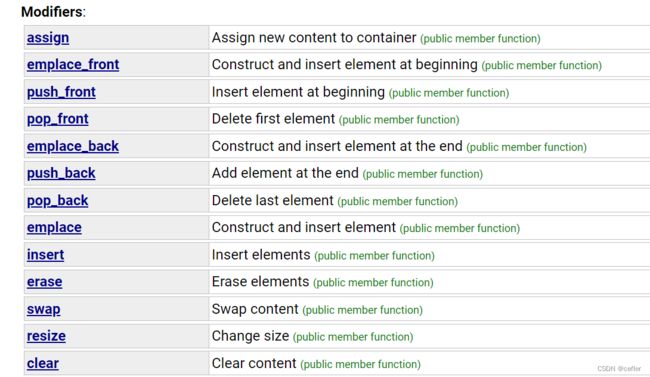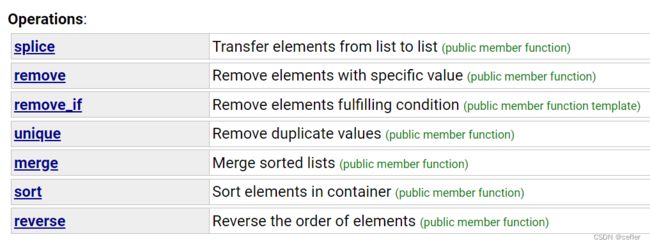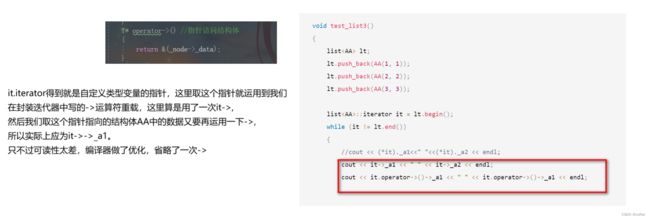List
欢迎来到Cefler的博客
博客主页:那个传说中的man的主页
个人专栏:题目解析
推荐文章:题目大解析2
目录
- List概念
- List constructor
- Iterators
- Capacity
- Element access
- Modifiers
- Operations
-
- sort
- merge
- unique
- remove
- splice
- list的模拟实现
-
- list_node(链表结点)
- 封装迭代器
- insert
- erase
- push_back
- 头插/删,尾插/删
- empty_init函数
- 无参构造函数
- swap函数、clear函数、拷贝构造函数、析构函数
- 迭代器的begin和end() 【非const】
- 插入自定义类型,编译器优化书写格式->
- const 迭代器
-
- 实现const 迭代器优化(增加模板参数)
- 实例化模板
- list.h
List概念
C++中的list是一种双向链表数据结构。它可以存储任意类型的元素,并且可以在常数时间内在任意位置插入或删除元素。list提供了许多操作,如在开头或结尾插入/删除元素,访问元素,以及在列表中搜索元素。与向量(vector)相比,list的插入和删除操作更高效,但是访问元素的效率较低。
List constructor
和vector差不多,list的构造函数中,有:
- 无参默认构造
- n个val值构造
- 模板函数,迭代器区间初始化构造
- 拷贝构造
List官方文档
Iterators
Capacity
Element access
Modifiers
Operations
sort
可能有人会问,std中不是有提供一个全局的sort函数,为什么list内部还要再支持一个sort接口?
我们看下原因


噢,原来是因为list的迭代器是双向迭代器,而std的sort只接收随机迭代器类型,因为双向迭代器不支持+/-功能,所以list用不了std的sort,只能自己造轮子了。

list的sort默认情况下是升序,list的排序有:
- 升序:< less
- 降序:> greater
list<int> l;
for (int i = 1; i <= 4; i++)
{
l.push_back(i);
}
//我们想要个降序
greater<int> gt;
// list l;
for (int i = 1; i <= 4; i++)
{
l.push_back(i);
}
//我们想要个降序
greater<int> gt;
//l.sort(greater ());匿名对象也可以
l.sort(gt);
list的sort底层是实现是用归并排序
std的sort底层实现是快速排序,要比list的排序快,所以有时候,如果数据量比较少一般直接用list的排序,
但如果数据量大的话,我们可以先将list里面的数据拷贝到vector上,然后借助vector用std的排序进行快排,排序完之后,用assign的迭代器区间再拷贝回list中,这样就可以偷梁换柱了。
#include
#include merge
合并两个链表,但是前提是这两个链表是有序的。
// list::merge
#include
// compare only integral part:
bool mycomparison (double first, double second)
{ return ( int(first)<int(second) ); }
int main ()
{
std::list<double> first, second;
first.push_back (3.1);
first.push_back (2.2);
first.push_back (2.9);
second.push_back (3.7);
second.push_back (7.1);
second.push_back (1.4);
first.sort();
second.sort();
first.merge(second);
// (second is now empty)
second.push_back (2.1);
first.merge(second,mycomparison);
std::cout << "first contains:";
for (std::list<double>::iterator it=first.begin(); it!=first.end(); ++it)
std::cout << ' ' << *it;
std::cout << '\n';
return 0;
}
输出:
first contains: 1.4 2.2 2.9 2.1 3.1 3.7 7.1
请注意,在第二次合并中,函数 mycompare(仅比较整数部分)没有考虑 2.1 低于 2.2 或 2.9,因此它入到它们之后,在 3.1 之前
unique
unique 函数的作用是将容器中相邻的重复元素保留一个,并删除其余的重复元素。具体而言,它会遍历容器中的元素,将相邻的重复元素中的后一个元素删除。
以下是 std::list 的 unique 函数的用法示例:
#include
int main() {
std::list<int> myList = {1, 2, 2, 3, 3, 3, 4, 5, 5};
myList.unique();
for (const auto& element : myList) {
std::cout << element << " ";
}
return 0;
}
输出结果为:1 2 3 4 5。
注意,unique 函数只能去除相邻的重复元素,如果容器中存在非相邻的重复元素,它们不会被去除。如果需要去除所有重复元素,可以先使用 std::sort 函数对容器进行排序,然后再使用 unique 函数
remove
remove 函数用于删除容器中指定的元素。
remove 函数的工作原理是遍历容器,找到所有与指定值相等的元素,并将它们从容器中删除。
remove 函数的语法如下:
void remove(const T& value);
splice
splice 是 std::list 类提供的一个成员函数,用于将另一个 std::list 的元素插入到当前 std::list 中的指定位置。
splice 函数的语法如下:
void splice (iterator position, list& x);
void splice (iterator position, list& x, iterator i);
void splice (iterator position, list& x, iterator first, iterator last);
- 第一个版本将 x 中的所有元素插入到当前 list 的 position 之前。
- 第二个版本将 x 中第i个元素开始之后的元素插入到当前 list 的 position 之前。
- 第三个版本将 x 中的 [first, last) 范围内的元素插入到当前 list 的 position 之前。
注意,splice 操作会改变被插入的 list,并且被插入的元素会从原来的 list 中移除。
以下是一个示例代码,演示了如何使用 splice 函数:
#include
int main() {
std::list<int> list1 = {1, 2, 3};
std::list<int> list2 = {4, 5, 6};
auto it = list1.begin();
std::advance(it, 2); // 将迭代器移动到第三个元素的位置
list1.splice(it, list2); // 将 list2 中的所有元素插入到 list1 的第三个元素之前
// 输出 list1 的元素
for (const auto& num : list1) {
std::cout << num << " ";
}
std::cout << std::endl;
// 输出 list2 的元素
for (const auto& num : list2) {
std::cout << num << " ";
}
std::cout << std::endl;
return 0;
}
输出结果为:
1 2 4 5 6 3
list的模拟实现
list_node(链表结点)
template <class T>//模板结构体,为了存储可能不同的数据类型
struct list_node //这边用strcut主要是想开放所有的成员变量,所以不用class
{
T _data;
list_node<T>* _next;
list_node<T>* _prev;
list_node(const T& val = T())
:_data(val)
, _next(nullptr)
, _prev(nullptr)
{
}
};
封装迭代器
template <class T>
struct __list_iterator//封装一个迭代器,实现迭代器的++/--等等功能,解引用
//迭代器牛逼之处
//封装屏蔽底层差异和实现细节
//提供统一的访问修改方式
{
typedef list_node<T> Node;
typedef __list_iterator<T> self;
Node* _node;
__list_iterator(Node* node)//传参进来
:_node(node)
{
}
self& operator++()
{
_node = _node->_next;
return *this;
}
self operator++(int)//后置++
{
self tmp(*this);
_node = _node->_next;
return tmp;
}
self& operator--()
{
_node = _node->_prev;
return *this;
}
self operator--(int)//后置--
{
self tmp(*this);
_node = _node->_prev;
return tmp;
}
T& operator*()
{
return _node->_data;
}
T* operator->() //指针访问结构体
{
return &(_node->_data);
}
bool operator!=(const self& s)
{
return _node != s._node;
}
bool operator==(const self& s)
{
return _node == s._node;
}
};
insert
iterator insert(iterator pos, const T& x)
{
Node* newnode = new Node(x);//先开辟新空间
Node* cur = pos._node;
Node* prev = cur->_prev;
prev->_next = newnode;
newnode->_prev = prev;
newnode->_next = cur;
cur->_prev = newnode;
//insert后pos仍指向原空间,迭代器没失效
++_size;
return iterator(newnode);
}
erase
iterator erase(iterator pos)
{
Node* cur = pos._node;
Node* prev = cur->_prev;//上一个结点
Node* next = cur->_prev;//下一个结点
prev->_next = next;
next->_prev = prev;
delete cur;
//delete之后,cur即pos指向的空间已经不是原空间了,迭代器妥妥失效了!
//所以需要返回删除位置的下一位置
--_size;
return iterator(next);
}
push_back
void push_back(const T& x)
{
//先建新空间
Node* tail = _head->_prev;
Node* newnode = new Node(x);
tail->_next = newnode;
newnode->_prev = tail;
newnode->_next = _head;
_head->_prev = newnode;
}
insert进行尾插:
void push_back(const T& x)
{
insert(end(), x);
}
头插/删,尾插/删
void push_back(const T& x)
{
insert(end(), x);
}
void push_front(const T& x)
{
insert(begin(), x);
}
void pop_back()
{
erase(--end());
}
void pop_front()
{
erase(begin());
}
empty_init函数
void empty_init()
{
_head = new Node;
_head->_next = _head;
_head->_prev = _head;
_size = 0;
}
无参构造函数
void empty_init()
{
_head = new Node;
_head->_next = _head;
_head->_prev = _head;
}
list()
{
empty_init();
}
swap函数、clear函数、拷贝构造函数、析构函数
void swap(list<T>& lt)
{
std::swap(this->_head, lt._head);
std::swap(this->_size, lt._size);
}
void clear()
{
_head->_next = _head;
_head->_prev = _head;
}
/* void clear() //全部清除版本
{
iterator it = begin();
while (it != end())
{
it = erase(it);
}
}*/
list( list<T>& lt)//拷贝构造
{
empty_init();
for (auto e : lt)
{
push_back(e);
}
}
~list()
{
//clear();
delete _head;
_head = nullptr;
}
迭代器的begin和end() 【非const】
typedef __list_iterator<T> iterator;
iterator begin() //返回值会将_head->_next的值拷入进行构造
{
//return (iterator)_head;这边无需强转
return _head->_next;
}
iterator end()
{
return _head;
}
插入自定义类型,编译器优化书写格式->
struct AA
{
AA(int a1 = 0, int a2 = 0)
:_a1(a1)
, _a2(a2)
{}
int _a1;
int _a2;
};
void test_list3()
{
list<AA> lt;
lt.push_back(AA(1, 1));
lt.push_back(AA(2, 2));
lt.push_back(AA(3, 3));
list<AA>::iterator it = lt.begin();
while (it != lt.end())
{
//cout << (*it)._a1<<" "<<(*it)._a2 << endl;
cout << it->_a1 << " " << it->_a2 << endl;
cout << it.operator->()->_a1 << " " << it.operator->()->_a1 << endl;
++it;
}
cout << endl;
/* int* p = new int;
*p = 1;
AA* ptr = new AA;
ptr->_a1 = 1;*/
}
const 迭代器
这不简单?我们已经写好了一个迭代器,直接const iterator不就好了。
但是list说:在哥的地盘上,你在string和vector使的那招不管用,我的规矩才是规矩。

这是为什么呢,list的规矩是什么呢?
首先为什么说直接const iterator不行呢?
list中的迭代器很特殊,它不像string和vector一样能直接实现++/–等功能。
所以我们要专门去封装一个迭代器类型,在内部自己造轮子,自己动手,丰衣足食。
而问题也出在这里,如果说我一旦const iterator,这一个const直接让整个迭代器瘫痪了,何出此言?我们定义一个const迭代器,本意上是让数据无法被更改,
结果好家伙,你不仅封印了const _data,还封印了++/–等功能,这不是扯淡吗,
现在连遍历都不得行了。

所以list的规矩就来了
既然这么直接const iterator这么难办,那我们只能再专门写一个const_iterator类型了,单独对其中的数据进行const这样就行了。
实现如下:
template <class T>
struct __list_const_iterator//封装一个const_iterator迭代器,
{
typedef list_node<T> Node;
typedef __list_iterator<T> self;
Node* _node;
__list_iterator(Node* node)//传参进来
:_node(node)
{
}
self& operator++()
{
_node = _node->_next;
return *this;
}
self operator++(int)//后置++
{
self tmp(*this);
_node = _node->_next;
return tmp;
}
self& operator--()
{
_node = _node->_prev;
return *this;
}
self operator--(int)//后置--
{
self tmp(*this);
_node = _node->_prev;
return tmp;
}
const T& operator*() //const一下
{
return _node->_data;
}
const T* operator->()//const一下
{
return &(_node->_data);
}
bool operator!=(const self& s)
{
return _node != s._node;
}
bool operator==(const self& s)
{
return _node == s._node;
}
};
实现const 迭代器优化(增加模板参数)
我们上述的实现const 迭代器的方法虽然可行。
但问题是代码太过冗余,我只是修改了operator*()和operator->(),而其它处的代码和iterator的都一模一样。
而解决办法也有,此时模板就开始展示它的威力了,
我们可以直接增加Ref(引用)、Ptr(指针)两个参数,然后分别tyepedef const和非const 的iterator,这样编译器就会自动匹配最适合的那个类模板。
template <class T,class Ref,class Ptr>
struct __list_iterator
{
typedef list_node<T> Node;
typedef __list_iterator<T,Ref,Ptr> self;
Node* _node;
__list_iterator(Node* node)//传参进来
:_node(node)
{
}
self& operator++()
{
_node = _node->_next;
return *this;
}
self operator++(int)//后置++
{
self tmp(*this);
_node = _node->_next;
return tmp;
}
self& operator--()
{
_node = _node->_prev;
return *this;
}
self operator--(int)//后置--
{
self tmp(*this);
_node = _node->_prev;
return tmp;
}
Ref operator*()
{
return _node->_data;
}
Ptr operator->() //指针访问结构体
{
return &(_node->_data);
}
bool operator!=(const self& s)
{
return _node != s._node;
}
bool operator==(const self& s)
{
return _node == s._node;
}
};
typedef __list_iterator<T,T&,T*> iterator;
typedef __list_iterator<T,const T&,const T*> const_iterator;//const迭代器
实例化模板
我们来看个例子:
template <typename T>
void Print_list(const list<T>& lt)
{
list<T>::const_iterator it = lt.begin();
while (it != lt.end())
{
cout << *it << " ";
++it;
}
}
void test_list4()
{
list<string> lt;
for (int i = 0; i < 4; i++)
{
lt.push_back("123");
}
Print_list(lt);
}
当我们在list< string >类型前加上typename后就可以了。
可是为什么模板函数下为什么要这样多次一举呢?
原因如下:
typename 这里就是具体实例化了一个模板对象,有了实例化对象后,编译器才可以去访问对象内部的情况,而这时,编译器才能知道如const_iterator是一个类型,
才可以初始化,那不然编译器判断不了到底是内嵌类型还是静态成员变量
list.h
#pragma once
#include
#include 如上便是本期的所有内容了,如果喜欢并觉得有帮助的话,希望可以博个点赞+收藏+关注❤️ ,学海无涯苦作舟,愿与君一起共勉成长










